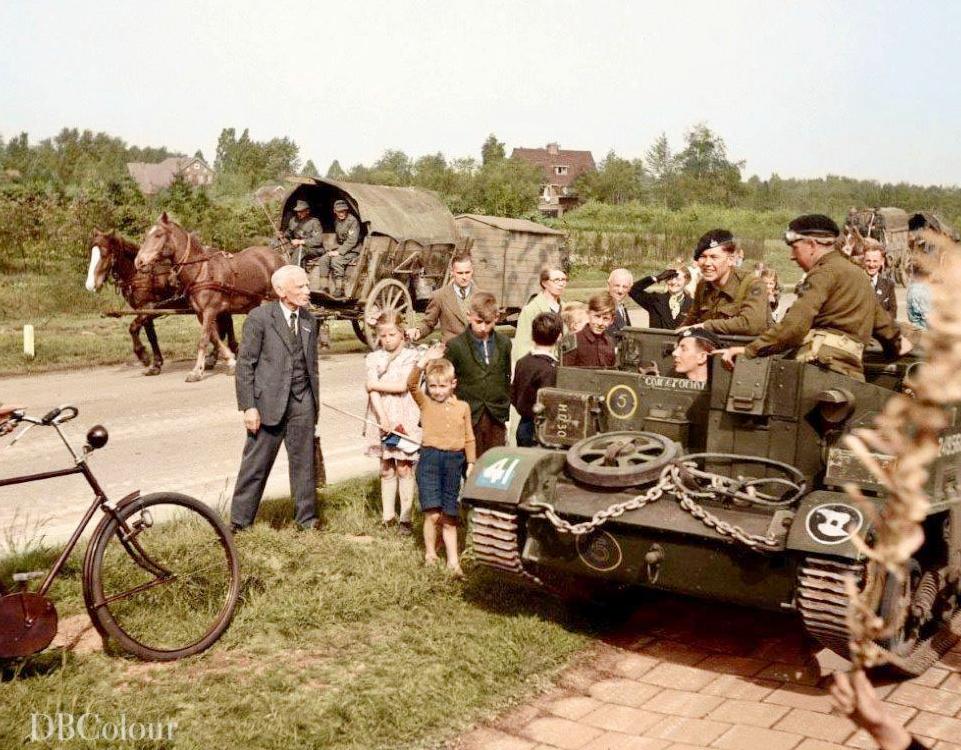
World War II Technology: Armored Tracked Vehicles--Utility Carriers

Figure 1.--Here we see a Universal Carrier operated by the the 49th (West Riding) Division Recce Regiment. This one does not seem to have a forward gun. The photograph looks to have been taken just after the German surrender in early May 1945. We see Dutch civilans coming over to check out the British vehicle and no doubt thank their liberators. The photograph was taken near Gooi, Noord-Holland. This is a town in central Netherlannds. As it was north of the Rhine, it was not liberated until the last days of the War and the peopole suffered the German imposed Hunger Winter. Notice the Germans in horse drawn wagons watching the reception of the British while they head back to a defeated and devestated Germany. The Germans no longer had gas to operate motor vehicles. Source: Nationaal Archief Materiaalsoort : Negatief (zwart/wit) Nummer archiefinventaris : bekijk toegang 2.24.01.03 Bestanddeelnummer : 900-2889).
|
|
The British universal carrier was commonly known as the Bren Gun carrier because of the light machine gun which many were armed with. It is a family of light armoured tracked vehicles built by Vickers-Armstrongs and other British companies. The universal Carrier family originated with the Carden Loyd tankettes, which was developed in the 1920s beginning with the Mk VI tankette. Production began in 1934. As far as we know, these universal vehicles type was only made by the British and used with British and Commonwealth troops. The first carriers, the Bren Gun carrier and the scout carrier, were delivered to British units before the outbreak of the War. A single improved design that could replace these specific designs, the universal carrier was introduced shortly after the outbreak of the War (1940). The universal carrier was a very versatile military vehicle. It was initially concetualied as a combat fire-power transport. The crew members were meant to dismount and engage the enemy. The Army used in many ways by different ways. It could carry mortars infantrymen, equipment, and supplies -- basically everything that needed to be transported. Tt was used as machine gun platforms on thefront lines. The supply function, howeerr, appears to have superceeded its actual combat use. The universal carrier's versatility meant that it played an important role for the British and Commonwealth forces in every World War II theater. The universal carrier had a crew of four, an NCO, driver-mechanic, and two riflemen. Some 113,000 of these vehicles were built, including some after the War. Most were built in Britain. It is the most widely produced armoured fighting vehicle in history. They were done in ennuerable variants.
CIH

Navigate the CIH World War II Pages:
[Return to Main World War II tracked vehicle page]
[Return to Main World War II land technology/tactics weapons page]
[Return to Main World War II land technology/tactics page]
[Return to Main World War II technology/tactics page]
[Return to Main World War II page]
[Biographies]
[Campaigns]
[Children]
[Countries]
[Deciding factors]
[Diplomacy]
[Geo-political crisis]
[Economics]
[Home front]
[Intelligence]
[POWs]
[Resistance]
[Race]
[Refugees]
[Technology]
[Bibliographies]
[Contributions]
[FAQs]
[Images]
[Links]
[Registration]
[Tools]
[Return to Main World War II page]
[Return to Main war essay page]
Created: 3:44 AM 9/6/2019
Last updated: 3:44 AM 9/6/2019



